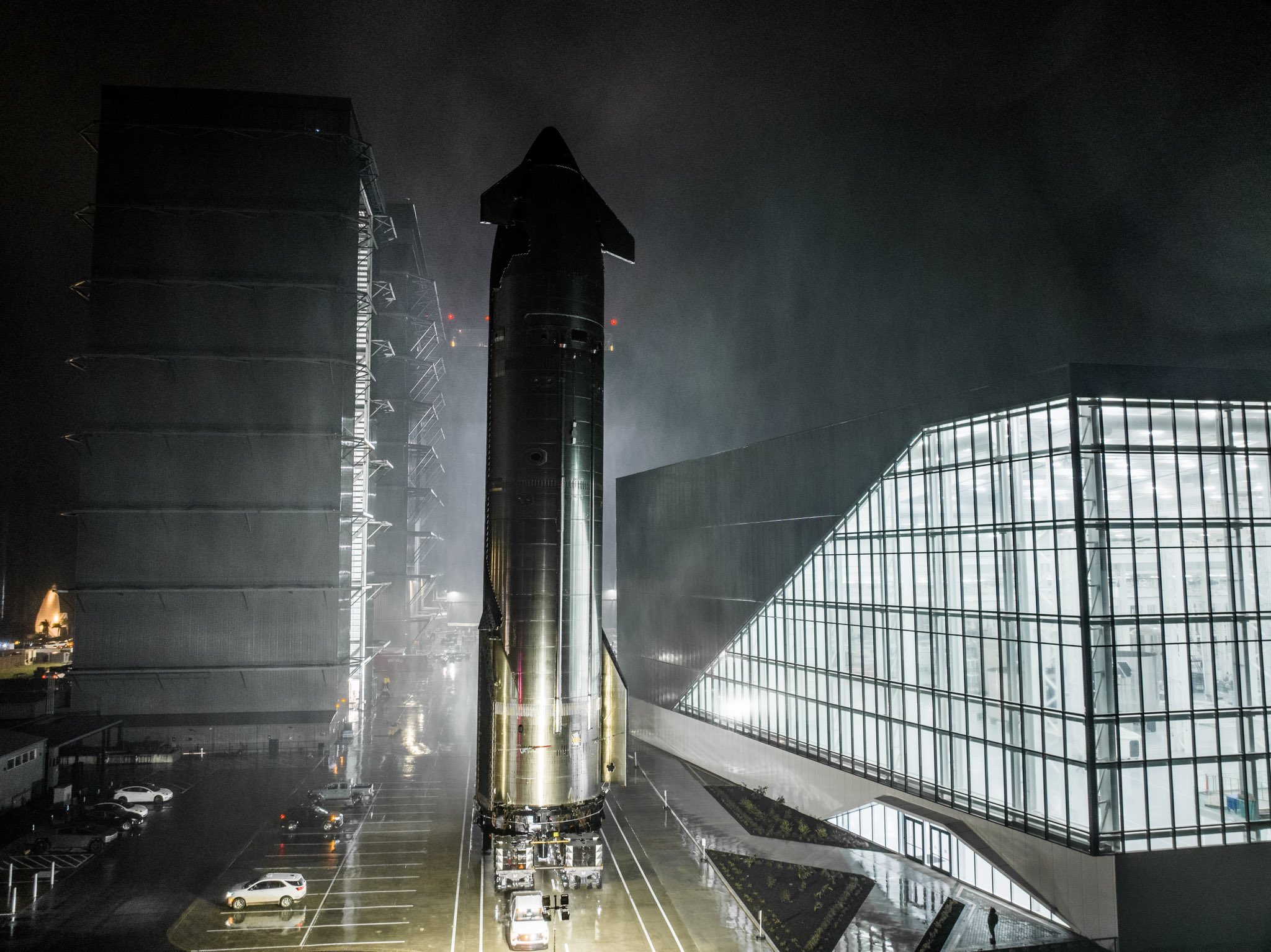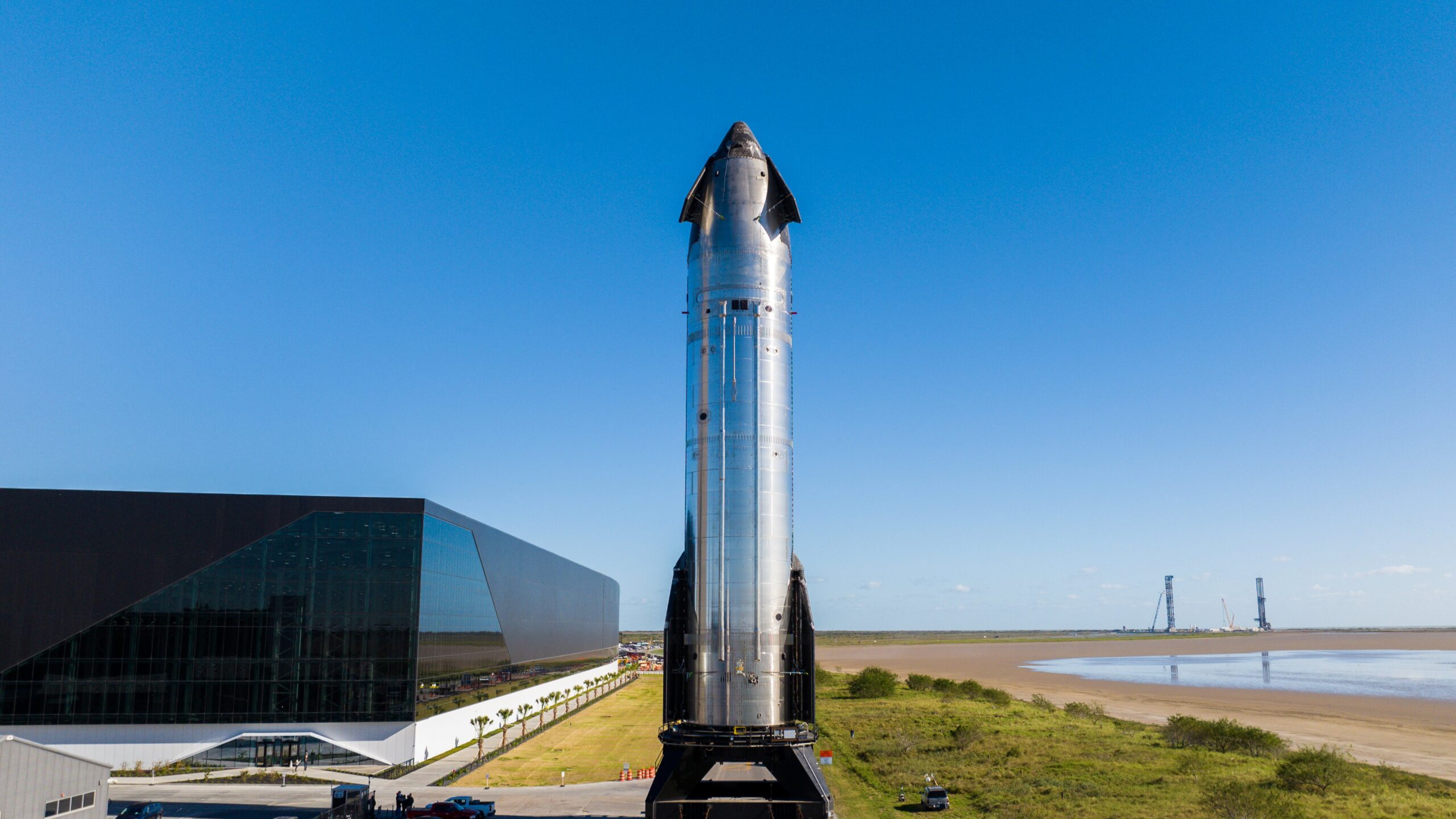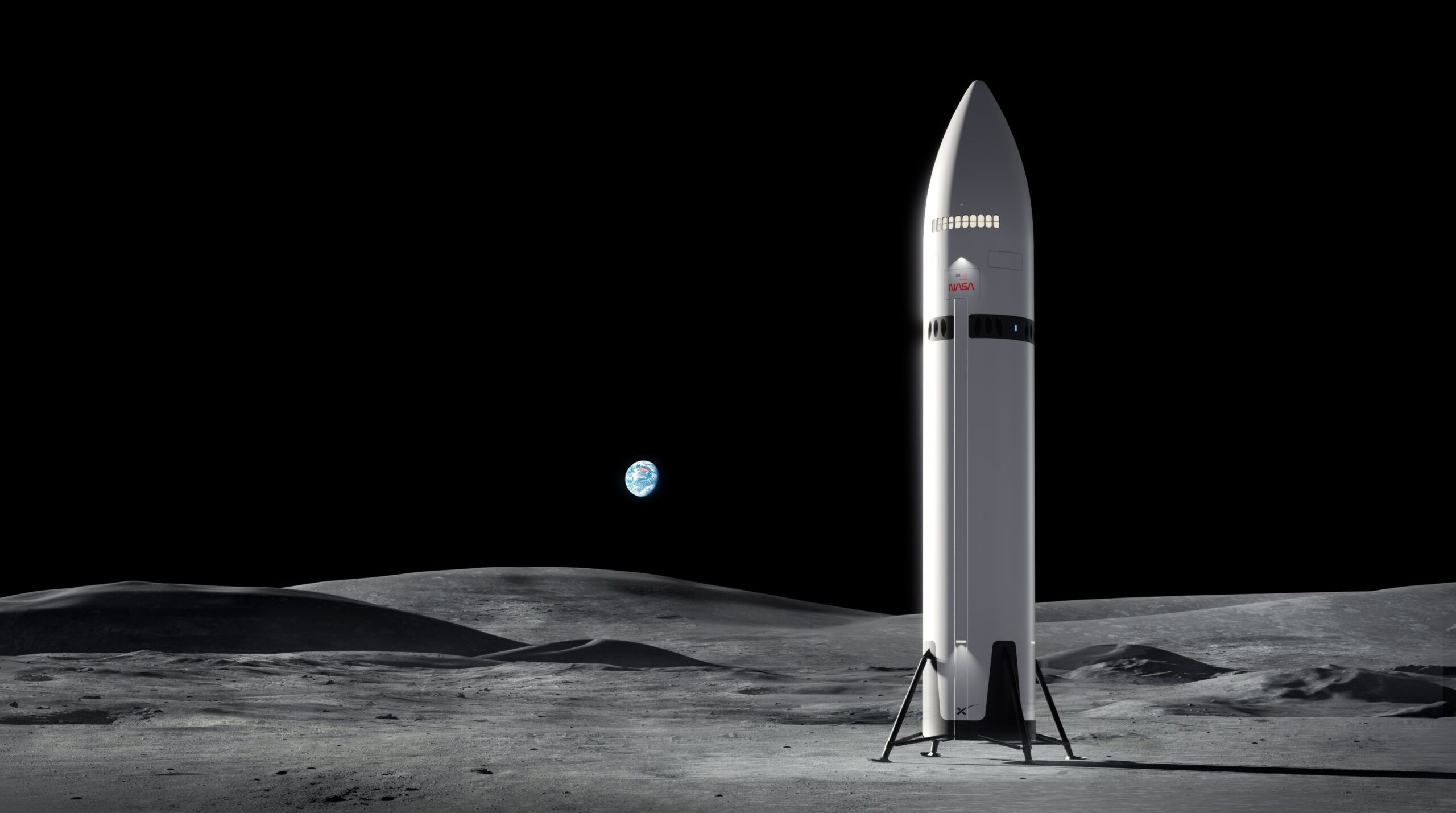Starship will test its payload deployment mechanism on its seventh test flight.
SpaceX's first second-generation Starship, known as Version 2 or Block 2, could launch as soon as January 13. Credit: SpaceX
An upsized version of SpaceX's Starship mega-rocket rolled to the launch pad early Thursday in preparation for liftoff on a test flight next week.
The two-mile transfer moved the bullet-shaped spaceship one step closer to launch Monday from SpaceX's Starbase test site in South Texas. The launch window opens at 5 pm EST (4 pm CST; 2200 UTC). This will be the seventh full-scale test flight of SpaceX's Super Heavy booster and Starship spacecraft and the first of 2025.
In the coming days, SpaceX technicians will lift the ship on top of the Super Heavy booster already emplaced on the launch mount. Then, teams will complete the final tests and preparations for the countdown on Monday.
"The upcoming flight test will launch a new generation ship with significant upgrades, attempt Starship’s first payload deployment test, fly multiple reentry experiments geared towards ship catch and reuse, and launch and return the Super Heavy booster," SpaceX officials wrote in a mission overview posted on the company's website.
The mission Monday will repeat many of the maneuvers SpaceX demonstrated on the last two Starship test flights. The company will again attempt to return the Super Heavy booster to the launch site and attempt to catch it with two mechanical arms, or "chopsticks," on the launch tower approximately seven minutes after liftoff.
SpaceX accomplished this feat on the fifth Starship test flight in October but aborted a catch attempt on a November flight because of damaged sensors on the tower chopsticks. The booster, which remained healthy, diverted to a controlled splashdown offshore in the Gulf of Mexico.

SpaceX's next Starship prototype, Ship 33, emerges from its assembly building at Starbase, Texas, early Thursday morning. Credit: SpaceX/Elon Musk via X
For the next flight, SpaceX added protections to the sensors on the tower and will test radar instruments on the chopsticks to provide more accurate ranging measurements for returning vehicles. These modifications should improve the odds of a successful catch of the Super Heavy booster and of Starship on future missions.
In another first, one of the 33 Raptor engines that will fly on this Super Heavy booster—designated Booster 14 in SpaceX's fleet—was recovered from the booster that launched and returned to Starbase in October. For SpaceX, this is a step toward eventually flying the entire rocket repeatedly. The Super Heavy booster and Starship spacecraft are designed for full reusability.
After separation of the booster stage, the Starship upper stage will ignite six engines to accelerate to nearly orbital velocity, attaining enough energy to fly halfway around the world before gravity pulls it back into the atmosphere. Like the past three test flights, SpaceX will guide Starship toward a controlled reentry and splashdown in the Indian Ocean northwest of Australia around one hour after liftoff.
New ship, new goals
The most significant changes engineers will test next week are on the ship, or upper stage, of SpaceX's enormous rocket. The most obvious difference on Starship Version 2, or Block 2, is with the vehicle's forward flaps. Engineers redesigned the flaps, reducing their size and repositioning them closer to the tip of the ship's nose to better protect them from the scorching heat of reentry. Cameras onboard Starship showed heat damage to the flaps during reentry on test flights last year.
SpaceX is also developing an upgraded Super Heavy booster that is slightly taller than the existing model. The next version of the booster will produce more thrust and will be slightly taller than the current Super Heavy, but for the upcoming test flight, SpaceX will still use the first-generation booster design.

Starship Block 2 has smaller flaps than previous ships. The flaps are located in a more leeward position to protect them from the heat of reentry. Credit: SpaceX
For next week's flight, Super Heavy and Starship combined will hold more than 10.5 million pounds of fuel and oxidizer. The ship's propellant tanks have 25 percent more volume than previous iterations of the vehicle, and the payload compartment, which contains 10 mock-ups of Starlink Internet satellites on this launch, is somewhat smaller. Put together, the changes add nearly 6 feet (1.8 meters) to the rocket's height, bringing the full stack to approximately 404 feet (123.1 meters).
This means SpaceX will break its own record for launching the largest and most powerful rocket ever built. And the company will do it again with the even larger Starship Version 3, which SpaceX says will have nine upper stage engines, instead of six, and will deliver up to 440,000 pounds (200 metric tons) of cargo to low-Earth orbit.
Other changes debuting with Starship Version 2 next week include:
• Vacuum jacketing of propellant feedlines
• A new fuel feedline system for the ship's Raptor vacuum engines
• An improved propulsion avionics module controlling vehicle valves and reading sensors
• Redesigned inertial navigation and star tracking sensors
• Integrated smart batteries and power units to distribute 2.7 megawatts of power across the ship
• An increase to more than 30 cameras onboard the vehicle.
Laying the foundation
The enhanced avionics system will support future missions to prove SpaceX's ability to refuel Starships in orbit and return the ship to the launch site. For example, SpaceX will fly a more powerful flight computer and new antennas that integrate connectivity with the Starlink Internet constellation, GPS navigation satellites, and backup functions for traditional radio communication links. With Starlink, SpaceX said Starship can stream more than 120Mbps of real-time high-definition video and telemetry in every phase of flight.
These changes "all add additional vehicle performance and the ability to fly longer missions," SpaceX said. "The ship's heat shield will also use the latest generation tiles and includes a backup layer to protect from missing or damaged tiles."
Somewhere over the Atlantic Ocean, a little more than 17 minutes into the flight, Starship will deploy 10 dummy payloads similar in size and weight to next-generation Starlink satellites. The mock-ups will soar around the world on a suborbital trajectory, just like Starship, and reenter over the unpopulated Indian Ocean. Future Starship flights will launch real next-gen Starlink satellites to add capacity to the Starlink broadband network, but they're too big and too heavy to launch on SpaceX's smaller Falcon 9 rocket.
SpaceX will again reignite one of the ship's Raptor engines in the vacuum of space, repeating a successful test achieved on Flight 6 in November. The engine restart capability is important for several reasons. It gives the ship the ability to maneuver itself out of low-Earth orbit for reentry (not a concern for Starship's suborbital tests), and will allow the vehicle to propel itself to higher orbits, the Moon, or Mars once SpaceX masters the technology for orbital refueling.

Artist's illustration of Starship on the surface of the Moon. Credit: SpaceX
NASA has contracts with SpaceX to build a derivative of Starship to ferry astronauts to and from the surface of the Moon for the agency's Artemis program. The NASA program manager overseeing SpaceX's lunar lander contract, Lisa Watson-Morgan, said she was pleased with the results of the in-space engine restart demo last year.
"The whole path to the Moon, as we are getting ready to land on the Moon, we'll perform a series of maneuvers, and the Raptors will have an environment that is very, very cold," Morgan told Ars in a recent interview. "To that, it's going to be important that they're able to relight for landing purposes. So that was a great first step towards that.
"In addition, after we land, clearly, the Raptors will be off, and it will get very cold, and they will have to relight in a cold environment (to launch the crews off the lunar surface)," she said. "So that's why that step was critical for the Human Landing System and NASA's return to the Moon."
“The biggest technology challenge remaining”
SpaceX continues to experiment with Starship's heat shield, which the company's founder and CEO, Elon Musk, has described as "the biggest technology challenge remaining with Starship." In order for SpaceX to achieve its lofty goal of launching Starships multiple times per day, the heat shield needs to be fully and immediately reusable.
While the last three ships have softly splashed down in the Indian Ocean, some of their heat-absorbing tiles stripped away from the vehicle during reentry, when it's exposed to temperatures up to 2,600° Fahrenheit (1,430° Celsius).
Engineers removed tiles from some areas of the ship for next week's test flight in order to "stress-test" vulnerable parts of the vehicle. They also smoothed and tapered the edge of the tile line, where the ceramic heat shield gives way to the ship's stainless steel skin, to address "hot spots" observed during reentry on the most recent test flight.
"Multiple metallic tile options, including one with active cooling, will test alternative materials for protecting Starship during reentry," SpaceX said.
SpaceX is also flying rudimentary catch fittings on Starship to test their thermal performance on reentry. The ship will fly a more demanding trajectory during descent to probe the structural limits of the redesigned flaps at the point of maximum entry dynamic pressure, according to SpaceX.
All told, SpaceX's inclusion of a satellite deployment demo and ship upgrades on next week's test flight will lay the foundation for future missions, perhaps in the next few months, to take the next great leap in Starship development.
In comments following the last Starship test flight in November, SpaceX founder and CEO Elon Musk posted on X that the company could try to return the ship to a catch back at the launch site—something that would require the vehicle to complete at least one full orbit of Earth—as soon as the next flight following Monday's mission.
"We will do one more ocean landing of the ship," Musk posted. "If that goes well, then SpaceX will attempt to catch the ship with the tower."










 English (US) ·
English (US) ·